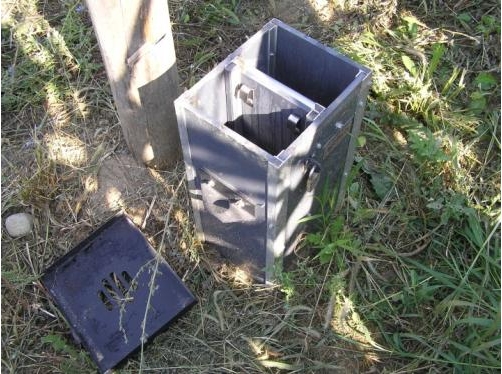
News
Protecting water through farm management
May 4, 2015 By Tim Harrigan/Michigan State University Extension
 Control structures maintain the water table at the desired depth. Integrating conservation practices throughout the farming system can keep crop nutrients in the root zone and out of waterways.
Control structures maintain the water table at the desired depth. Integrating conservation practices throughout the farming system can keep crop nutrients in the root zone and out of waterways.May 4, 2015, Clayton, MI – Integrating conservation practices throughout the farming system can keep crop nutrients in the root zone and out of waterways.
Water quality problems linked to the loss of crop nutrients has drawn attention to on-farm nutrient management. The city of Des Moines, Iowa is pursuing a lawsuit against three Iowa counties that manage drainage districts traced to high concentrations of nitrates. Nitrogen (N) and phosphorus (P) runoff from farm fields in the upper Midwest are contributing to oxygen depletion, fish kills and “dead zones” in the Mississippi River and Gulf of Mexico. Nonpoint pollution sources now make up the largest, although highly variable, source of total phosphorus leading to excessive algae growth and disruption of fisheries in Lake Erie. Soil conservation practices have greatly reduced sediment and nutrient loss, but cropland is nutrient-rich and natural levels of N and P in lakes and streams is very low. Even low amounts of runoff from large areas can degrade water quality and the upset the balance of aquatic life.
Blaine Baker, co-owner of Baker Lad’s Farm in Clayton, Mich., and Tom Van Wagner, Technical Coordinator for the Lenawee Conservation District Center for Excellence Program explained how, at a recent conference co-sponsored by the Michigan Chapter of the Soil and Water Conservation Society and Michigan State University Extension, Baker Lad’s Farm manages the entire farming system to protect water quality.
Much of the most productive farmland in Michigan is tile drained. Tile drainage improves infiltration and reduces runoff, increases water storage, and creates a suitable environment for plant growth by removing excess water. While tile drainage has economic and environmental benefits, under some conditions excess nutrients from commercial fertilizers and livestock manure can quickly move to tile drains through preferential flow paths; cracks and fissures in the soil, worm holes, root channels and other macropores, and thereby escape from the field.
At the Baker Lad’s Farm, they use a closed-loop nutrient recycling system to prevent contaminants from escaping to the environment. A 20-acre sub-irrigation system with water table management provides efficient use of two million gallons of “gray water” from the dairy milking centre and runoff from the feed storage and processing area. The dilute wastewater is cycled through a three-stage wetland for biological treatment and retention before being pumped through the sub-irrigation system to meet the water and partial nutrient needs of 10 acres of corn during the growing season. Drainage control structures maintain the depth of the water table about 18 inches below the surface. Tile outlets are plugged during the growing season to prevent effluent from reaching the drainage ditch.
In dry years, corn yields have increased as much as 70 bushel per acre from efficient use of the wastewater. At the end of the growing season, when the water tests clean, the drain plugs are removed and excess water is drained to the open ditch.
One of the greatest benefits of this system is the efficient removal and reuse of two million gallons of dilute wastewater from the farm.
Soil health and sustainability are at the centre of the Baker Lad’s cropping system. Healthy soil is resilient and productive. Healthy soil balances the physical, chemical and biological properties that enhance its ability to produce quality crops and protect the environment. Healthy soil has stable aggregate structure for stand establishment and crop/root growth, water infiltration, drainage and aeration. Healthy soil retains nutrients in the upper soil layer and minimizes leaching losses, and can mobilize nutrients when needed for crop growth.
Their cropping program is 100 per cent no-till and cover crops are used on 100 per cent of the crop acreage to trap and cycle nutrients, prevent soil erosion and build soil organic matter. While aerial seeding was previously used to seed cover crops they now use a 90-foot high-boy sprayer equipped with an air-seeder and drop pipes on 30-inch centres to seed cereal rye, annual ryegrass or an annual ryegrass/clover mix in standing crops. They have greater crop yields with a cover crop than without.
Retaining nutrients in the root zone is a high priority on the farm and they keep tight control over nutrient inputs. All fields are grid soil sampled and commercial fertilizers are applied as close to planting as possible using variable rate application (VRA). No phosphorus-based commercial fertilizers are applied in the fall to avoid runoff losses, and they avoid two-year spreading rates. Manure land application from the 450-cow dairy is based on soil test results and a manure analysis. Split applications of N on the corn ground include a portion applied through the planter with make-up sidedress N based on a pre-sidedress nitrogen test (PSNT). They are beginning to adopt crop sensors for real-time VRA nitrogen applications and mapping.
In general, farms in the Great Lakes Region are not losing much N and P on a per acre basis, but the watersheds are large and freshwater is sensitive to even small increases in nutrient concentration. Because nutrient loss is greatly influenced by the timing and intensity of rainfall, the solution to the problem of nutrient loss and eutrophication of lakes and streams is neither simple nor obvious. There is a need to evaluate the farming system for new opportunities to retain crop nutrients, and for continued water quality monitoring, research and education. The Baker Lad’s Farm is just one example of how integrating conservation practices throughout the farming system, and attention to detail in on-farm nutrient management can keep crop nutrients in the root zone and out of waterways.
Print this page